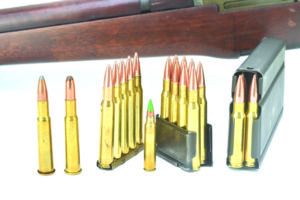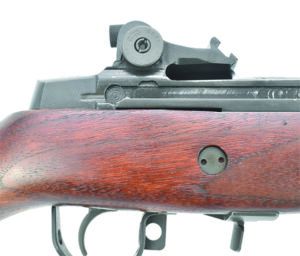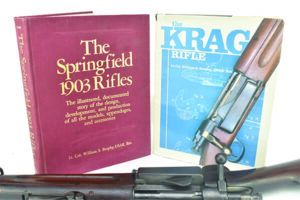Do you ever look at an old firearm and wonder what stories it could tell you? We do. So, we are going to bring you four rifles, all produced by Springfield Armory over a period of some 85 years, and tell you a few of their tales. Perhaps their back stories will light a spark of interest in you to look at one of these items for yourself.
First up is an 1898 Krag-Jorgensen that has been modified by various owners.
Next is a Springfield ‘03 with a receiver that dates to 1931 and the barrel to 1928. That one was rebuilt by the government around the end of World War II and still looks great.
This is followed by an M1 Garand that serial-number records show was built in 1943. This one was a Director of Civilian Marksmanship sale, and we see the barrel was replaced at some point.
The last is a National Match M1A we believe was produced in the mid-1980s. This M1A is a semi-auto version of the famous M-14 and was used by a long-deceased friend in NRA High Power matches over a number of years.
Springfield Armory (located in the city of Springfield in western Massachusetts) was an arsenal for the U.S. federal government from 1777 until its closing in 1968. Obviously known for their firearms, Springfield also helped introduce concepts such as interchangeable parts and the assembly-line method of mass production to the industrial world. Our sources tell us that these innovations allowed Springfield Armory, thus the Union, to outproduce Confederate firearms production by a factor of 32 to 1. Robert McNamara announced the closing of Springfield Armory in 1968, and it lay dormant until the Reese family bought the rights in 1974. Their initial efforts stayed true to the history of the brand with the production of M1 Garands, 1911-style pistols and a semi-auto version of the M-14. As of 2021, Springfield Armory is one of the larger producers and firearms importers in the U.S., having added AR-15 and AR-10 style rifles to the product mix, along with the excellent XD and XDM lines and more. The year of 2020 saw the release of the Waypoint, a lightweight hunting/precision bolt-action rifle.

To see what these rifles could do, we fired them at American Shooting Centers in west Houston. We used a Caldwell TackDriver front bag and a large rear bag from T.A.B. Gear. Groups were shot with iron sights at targets 100 yards away. Keeping the age of the rifles in mind, we babied them with our ammo selections. For the Krag, we used 30-40 Krag Winchester 180-grain Power-Points. Ammo for this chambering is normally produced in limited quantities, so if you find some and you have a Krag, jump on it. Based on published advisories and a great deal of experimenting (see the June 2021 edition of Gun Tests for our report on Garands and gas plugs), we used reloads for the ’03 as well as the Garand. These consisted of 155-grain Sierra Match King bullets on top of Remington brass, CCI large rifle primers, and IMR 4895 powder. According to the manuals, our pressures should have been in the low 50,0000-psi range. The M1A was fed a well-proven 308 Winchester load consisting of 168-grain Sierra Match King bullets on top of Varget powder and Federal Gold Medal Match large rifle primers. Velocities were measured via Doppler radar as provided by LabRadar. Approximate values of the rifles were determined by researching internet auction sites such as Gunbroker.com to see what buyers were bidding on comparable items.
Here’s what to know about these rifles before you commit your hard-earned money to purchasing one.
Gun Tests Grade: A
~$1899
Our rifle timeline has now reached into the late 1940s. WWII is over and the North Atlantic Treaty Organization (NATO) has been constituted. With the idea that member nations’ small-arms ammunition should be as interchangeable as possible, trials begin for a new battle rifle. Propellant technology has advanced, and this affects the process. It is now more or less possible to achieve the same velocities as the 30-06 round with the same bullet weight in a shorter, lighter cartridge. Even before official military acceptance, Winchester recognized the promise of the new cartridge and introduced the civilian round now known as the 308 Winchester. Shortly thereafter, the militaries of NATO countries followed suit. Britain adopted the FN-FAL as designed by FN Herstal in Belgium, naming their version of the rifle the L1A1. All told, some 90 countries around the world would eventually use the FN or some variant.
| Action Type | Semi-auto, gas operated |
| Overall Length | 44.3 in. |
| Barrel Length/Twist | 22.0 in., 1:11 in. |
| Overall Height w/o Scope Mount | 8.0 in. |
| Weight Unloaded | 9.5 lbs. |
| Weight Loaded | 10.4 lbs. |
| Sight Radius | 27.2 in. |
| Action Finish | Blued |
| Barrel Finish | Blued |
| Magazine Capacity | 20 |
| Magazine Type | Detachable box |
| Stock | Walnut |
| Drop at Comb | 1.0 in. |
| Drop at Heel | 1.3 in. |
| Bedding | Glass bedded (aftermarket, we believe) |
| Buttplate | Steel |
| Length of Pull | 13.25 in. |
| Receiver Scope-Base Pattern | M1A pattern, base mounts on left side of receiver |
| Trigger Pull Weight | 3.75 lbs. |
| Safety | Pivoting latch in front of trigger guard |
| Warranty | Lifetime |
| Telephone | (800) 680-6866 |
| Website | Springfield-Armory.com |
| Made In | USA, Illinois |

The US already had the M1 and decided to stick with a modernized version of a very successful rifle, adopting the M-14 in 1959. It served as the primary U.S. rifle until 1964 when our military began to replace it with the M-16. General service use for this rifle lasted a mere five years. Or did it? General use, yes, but the military’s soldiers figured out later that, when they operated in the desert, possible engagement distances increased and something a bit more powerful than the 5.56 round was needed. But what did they have in their inventory that could fit the bill?
The National Rifle Association is well known as a lobbying organization that helps American gun owners protect their firearms rights. It is also the largest firearms usage and safety trainer in the world. One of the ways they promote this is firearms competition, with NRA High Power rifle matches being a staple. Under NRA rules, the service rifle division, before the availability and maturation of the MSR platform, was where the M-14 got a chance to shine. Tight tolerances on the moving parts, match barrels, match sights, and match triggers were all tightly glass-bedded into the walnut stocks. The process created some tools capable of shooting great scores at distance. The accurized AR-15 may have supplanted the M-14 as the go-to rifle for NRA matches, but those same tricks of the trade brought the M-14 back for another tour of duty in the deserts of the Middle East. As a result, the “shortest-lived” service rifle has now been in action with our militaries for more than 50 years.

All that was well and good, but M-14s are select fire, meaning that it would be time consuming, expensive, and a general pain for the average citizen to try to acquire one for High Power matches. Enter the Reese family and their newly reconstituted Springfield Armory. The Reese family not only brought back the name, they specialized in modern productions of M1 Garands, 1911-style pistols, and a semi-auto only version of the M-14, henceforth known as the M1A. Their updated version of the M-14 copies the improved gas system, bolt, and operating rod as compared to the M1 Garand. Gone also is the eight-round en-bloc clip, utilizing instead a 20-round detachable box magazine. Also, 5-, 10-, and 30-round mags are available and no more “M1 thumb.”
Our sample has a standard-profile National Match barrel and trigger group. They are bedded into the stock so tightly (almost certainly an aftermarket job) that the action is difficult to remove. The trigger measured a very nice 3.75 pounds. We need to check our NRA Service Rifle rules, but that just might be a bit light. The rear sight is National Match as well, with a hooded aperture. The sight is easily zeroed for 100-yard use. Elevation and windage adjustments are in ½-moa increments. Movements are sharp and crisp. At 0.062 inch wide, the front sight is thinner than the standard sight, allowing for a more-precise sight picture. This M1A is capable of some fine shooting, to the point where we would like to consider a good scope for it. Perhaps a good low-powered variable optic would work well. But then we run up against one of the few weaknesses of the M1A, and that is the ability to mount a scope where it will stay secured and zeroed. M1A receivers are drilled and tapped on the left side with longitudinal grooves running fore and aft of this hole. With most scope mounts, a knurled nut is threaded through a scope mount and tightened onto the receiver. The grooves help keep the mount lined up. Not being in the mood to tack-weld the scope mount onto the receiver (as do many military armorers), we have never been able to get the optics to stay as quite as consistent as we would like. If you decide to go this route, check with the Springfield Armory Custom Shop. We understand that they have some wizards there that can perform miracles on the scope mounts.

This M1A consistently outshot us. Match reloads consisting of 168-grain Sierra Match Kings over Varget powder and Federal Gold Medal Match primers averaged 2617 fps and 1.72-inch groups — right at half the group sizes of the other rifles. With the rear sight zeroed at 100 yards, moving the sight to the 400-yard marker yielded consistent hits on a torso-sized target at 400. We understand the reasons the military went to the ArmaLite AR-15 platform and all the advantages of lighter guns and bigger ammo loads. Nevertheless, we would say that no 5.56mm round says “Stop” quite like a 308 Winchester.
The Bottom Line
Which rifle would we start a collection with today?
- A sure bet, with great accuracy and gorgeous lines, would be the M1A. They are readily available, both new and used.
- The Garands are becoming more difficult to find, and their prices reflect that. Keep in mind that you are far more likely to find a great shooter than a true collector’s item. Still, good samples are available with a bit of looking and research. They are a fascinating piece of history from the Greatest Generation and are a must for the collector of American historical pieces.
- The 1903s, especially the versions before the A3 models, are our sentimental favorites, but their prices go up and selection lessens every year.
- As shooters, we probably enjoyed shooting the Krag-Jorgensen most of all. Be aware that unscrupulous souls have counterfeited many of the carbines, so do your homework carefully before adding a Krag to the collection. But if you find a good one, you’ll be transported back more than a hundred years every time you pull the trigger.
Range Data
| Rifle Load | Krag-Jorgensen 30-40 Krag Winchester Factory 180 Grain | 1903 Springfield 30-06 Springfield SMK Reload 155 Grain | M1 Garand 30-06 Springfield SMK Reload 155 Grain | M1A 308 Winchester SMK Reload 168 Grain |
|---|---|---|---|---|
| Average Velocity | 2253 fps | 2735 fps | 2818 fps | 2616 fps |
| Standard Deviation | 14.3 fps | 14.2 fps | 11.0 fps | 16.8 fps |
| Muzzle Energy | 2030 ft.-lbs. | 2572 ft.-lbs. | 2645 ft.-lbs. | 2357 ft.-lbs. |
| Best Group | 2.68 in. | 2.42 in. | 2.57 in. | 1.51 in. |
| Average Group | 3.37 in. | 3.04 in. | 3.36 in. | 1.72 in. |
Testing was done at American Shooting Centers on the west side of Houston. All shots were fired from a well-sandbagged position using a Caldwell TackDriver rear bag and a T.A.B. Gear large/heavy rear bag. Muzzle velocities were measured via LabRadar ($559).




























Your article helped me a lot, is there any more related content? Thanks!